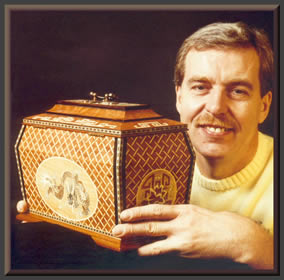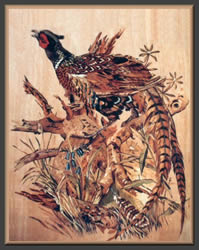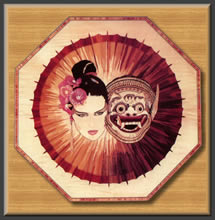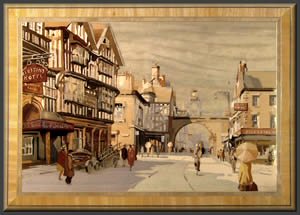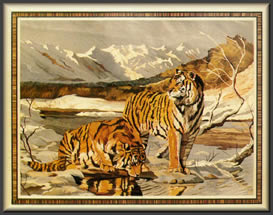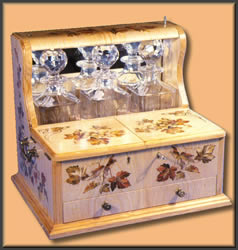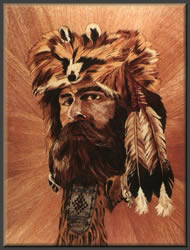|
 |
|
![]()
INTERVIEW NUMBER 2
C. Alan, have you always been involved with wood in some form or other? Alan. Over 45 years ago, on leaving school, I started work at a piano making factory. After about a year and a half of making tea at lunch and tea break and helping out behind the planers, saws and sanding machines, I was given the opportunity to help out in the veneer shop as a trainee veneer preparer. C. Where did you first come into contact with any marquetry? Alan. It was here that I saw my first piece of marquetry being made by the old guy who eventually showed me the basics of veneer preparing. Having seen his attempts at a very simple picture I decided if I could not do better then maybe I should change my trade!!! After several attempts my very simple pictures, completed during lunch and tea breaks, became quite popular among fellow workers. I started making about one a week and selling at ten shillings each (That shows my age). Chessboards, cribbage boards soon followed and even a fire screen with a kingfisher on it laid with Scotch glue and pressure applied with a toolbox! C. It seems to have been very basic so was it costly? Alan. The best thing about this hobby was that it was so cheap as the materials were all around. At this stage I was still using gum tape to hold my pieces together therefore every piece of veneer required a piece of tape which meant that the work was becoming thicker and thicker. C. How did you get round this problem? Alan. A very early `visit of discovery' to the Redbridge Group, and a chat to Derek Austin opened my eyes to P.V.A. Where were all the discarded pieces of tape on the floor? Using P.V.A. I could now cut many intricate pieces without my work becoming as thick as a piece of hardboard. C. Did this change of method make you want to get deeper into the craft? Alan. Being self-taught is all right up to a point but it is no substitute for belonging to a group. It wasn't till much later I heard about the Society and I made my first visit to a National. This was in 1980 and it was at Ipswich I believe. What I saw was an eye opener. The Rose Bowl winner that year was `The steam boat race' and the one I always remember was a black and white silhouette of a South African stamp and I thought then I could never live with these even at Beginners level. It was some time later that, on the advice of Pat Austin that I helped to start the Chelmsford Group and soon we were competing at our first National. C. Who were the leading marquetarians at that time? Alan. The top marquetarians at the time were Charlie Good and Richard Shellard. Charlie was my inspiration and although Richard has since passed away I could never associate some of his work with traditional marquetry, good though his work was. Having said that, it still pays to watch and digest all techniques from everybody's work. C. What sort of designs attracts your attention? Alan. In my early days of being a member of both Chelmsford and the Society I only made pictures using line drawings that came with the Marquetarian. It was a big step (as it is for most) to start tracing my designs from books, cards or calendars. To maintain interest in my work I like to cut pictures in subjects that interest me. For instance, I don't do street scenes or buildings etc. I share an affinity with the native American Indians, so a lot of my work revolves around this subject and I like to think this shows in my pictures. Animals and birds are good also because they have the earthy colours present in most veneers. C. Like many of us you get your designs from many places so do you work from a colour or black and white print? C. Do you take on commissions or is the majority of your work done for the excitement and challenge? Alan. I sometimes do commissions, but most of my work is done for the National Exhibition and I only manage about two or three items a year. Sometimes ideas come, as a challenge, from reading books. For example the New York best seller `Flags of our Fathers' led me to doing `Old Glory', a famous World War 2 photo of the flag raising on Iwo Jima . One day I hope to do something on the Custer Story, a big reading matter of mine. C. Do you enjoy Applied work as a change from pictures? Alan. As an aspiring cabinetmaker I derive a lot of pleasure producing applied work, after all this is where marquetry started. This type of work sometimes requires more originality in design. I nearly always draw full size plans (no, I am not a computer buff) and on occasions make a full size mock up using MDF. Much more patience is needed with applied work, as there may be four sides, all matching, to a box, two sides to a clock and many panels for a cabinet or table. But it can be rewarding and well worth the effort when completed. After all you can't have many cups of coffee on a picture! C. You have always been renowned as a fast worker. Have you always been like this? Alan. When the Chelmsford group had been formed we welcomed Gordon Baker who joined after a few weeks. He brought along a very nice Japanese screen of birds and blossoms. When asked how long it took to complete he replied " About a year". It was at that moment I decided that I would give up `a picture a week' and spend more time on one subject. So when asked which picture has given me most satisfaction, I have to say Bluebell Wood, only the third piece of work that I spent over three months to complete. When it was only partially complete I took it along to one of my visits to Redbridge where Derek Austin said it could be a Rosebowl contender, some praise indeed.
Alan. When asked about the use of dyed or coloured veneer I personally do not use them, as they are usually dyed maple and are very plain without much grain movement. So I would liken it to using and cutting coloured gummed paper like we did at primary school. (Wait for the flack). Having said that, there is another product on the market called `Alpi'. This is a man made veneer from Italy that tries to simulate the real thing and might be worth considering. Don't ever try to combine natural woods with dyed as this just does not work. I tried it once in `Cornfield Scenario' and fell foul of the comments of Charlie Good. Never never again. C. So what would your approach be if you were confronted, when judging, with a picture that made a great use of coloured wood? Alan. The picture would have to be exceptional to have any impact with me. In my view I could only see them used in cartoon type pictures. For more advanced work I would advise everyone to use natural woods. Having said that, there is a difficulty when it comes to use on applied work. Here it is a different proposition as less wood character is required. C. You have frequently been asked to judge competitions. Do you enjoy it? Alan. I've done many intergroup and group competitions and probably ruffled a few feathers, sometimes being a bit abrasive and saying what I think (not always the best policy). I have personally judged at two Nationals and loved every minute of it. There's a sense of power and I think football referees have that same feeling.
C. So what do you look for when you first see the exhibits? Alan. Seriously, as a judge, you get to see the exhibits first hand and have plenty of time to study the workmanship. Personally I make my first judgement on the appeal of the piece, then the use of the veneer, cutting, but not always on the finish. A little leniency needs to be applied. C. Do you think there is a case for re-introducing `Judges Comments' into the Marquetarian? Alan. Maybe Judges Comments should be brought back in the magazine, because not all members can be present at the National and apart from Independent Members asking for comments sheets, they may never know what the judges have to say. Though some people can take these comment too seriously. After all don't let's get carried away, it is only a hobby and a bit of fun. C. Have you seen many changes in marquetry in all the time that you have been involved? Alan. Over the years I have seen big changes in style, workmanship and technique. 30 years ago pictures incorporated large pieces of veneer using shade, grain, burrs etc to tell the story. Those same pictures would, these days, struggle to hold their own in the Secondary Class. These days, it seems to win awards, you need to cut thousands of small pieces to get anywhere. Maybe we need to find a middle ground. As a veneer preparer I have been lucky because I have had to adapt to different veneers, learned many techniques such as patching, finger joining and cutting very quickly. All these I have incorporated in my work and hobby.
C. Over the years the arguments over whether marquetry is an art or craft often crop up. Where do you stand on this topic? Alan. Academically I am not clever, so I can't use fancy words to describe whether marquetry is an art or a craft. All I can say is that I am not an artist, I am a craftsman, and so I will consider it a craft, full stop! I don't think there is a need to add more ideas to our work such as pyrography, velvet or felt. It's all been tried before and failed. What members do with their work when not exhibiting is entirely up to them. I have always been a creative person on many fronts. As a young lad it was Meccano, then plastic model kits and 45 years on, being given the raw materials and turning it into something to be appreciated for the future. C. Marquetry is a major part of your leisure time so do you manage to fit other interests in? Alan. I have been very fortunate to find a job that I enjoy because it's been my life and I will be the first to admit it has been a big advantage when cutting and choosing veneer for marquetry. I reckon my work mates, over the years, must think of me as a bit of an anorak spending hours standing at a bench then standing to do my hobby. Yes standing, I only do it standing up. When I am not cutting I spend my time in the garden. I keep a few koi carp; try to grow bonsai trees, though not for miniatures, have an interest in grasses and also have a Japanese garden. You will find me most evenings doing marquetry with earphones on listening to football commentary, usually from Manchester United, who I have supported for over 50 years (a dyed in the wool red!!) Another pastime is buying and reading books on native American history. I have a largish collection and this is a double-edged sword as it provides me with picture material. I must also mention first and last interest this being my wife, Anne, who stands by my every comment on all my work and who pushed mightily for me to start the Chelmsford Group. C. Thank you Alan |
||||||||||||||
